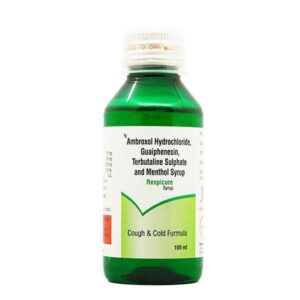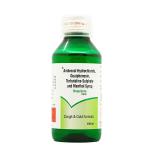AMBROXOL + MENTHOL + TERBUTALINE + GUAIPHENSIN
Ambroxol: Ambroxol is a medication that is primarily used as an expectorant to help loosen and thin mucus in the airways. It is commonly prescribed for conditions such as chronic bronchitis, asthma, and other respiratory tract infections where there is excessive mucus production.
The mechanism of action of ambroxol involves increasing the production of a substance called surfactant. Surfactant plays a crucial role in the functioning of the lungs by reducing the surface tension of the fluid lining the airways. By increasing surfactant production, ambroxol helps to improve the clearance of mucus from the respiratory tract, making it easier to cough up and expel.
Ambroxol is available in various formulations, including oral tablets, capsules, syrups, and inhalation solutions. The dosage and duration of treatment depend on the specific condition being treated. It is typically taken orally, with or without food, and the usual adult dose ranges from 30-60 mg per day divided into two to three doses. However, it is important to follow the instructions provided by your healthcare provider.
Common side effects of ambroxol may include gastrointestinal symptoms such as diarrhea, nausea, and stomach discomfort. In rare cases, allergic reactions like rash, itching, or swelling may occur, and immediate medical attention should be sought if such symptoms develop. It is always advisable to consult a healthcare professional for personalized advice and to determine if ambroxol is the appropriate medication for your condition.
Menthol: Menthol is a naturally occurring compound derived from the oil of peppermint or other mint plants. It is widely used in medicine and personal care products due to its cooling sensation and minty aroma. Menthol can be found in various forms, including creams, ointments, sprays, lozenges, and gels.
One of the primary uses of menthol is as a topical analgesic to provide temporary relief from minor aches and pains of muscles and joints. It works by activating the cold-sensitive receptors in the skin, causing a cooling sensation that helps numb the area and alleviate pain. Menthol is commonly used to relieve pain associated with conditions like arthritis, muscle strains, and sprains.
When using menthol topically, it is important to follow the dosage instructions provided on the product label. Generally, a thin layer of the cream or gel should be applied to the affected area and gently massaged in until it is absorbed. It is recommended to wash your hands after applying menthol to avoid accidentally getting it in your eyes or other sensitive areas.
Most people tolerate menthol well when used as directed. However, some individuals may experience side effects such as skin irritation, redness, or a burning sensation at the application site. If these side effects persist or worsen, it is advisable to discontinue use and consult a healthcare professional.
Menthol should not be ingested or applied to broken or irritated skin, as it may cause further irritation or adverse reactions. Additionally, individuals with known allergies to menthol or mint should avoid using products containing menthol.
In summary, menthol is a commonly used topical analgesic that provides temporary relief from minor aches and pains. It acts by activating cold receptors in the skin, creating a cooling sensation. It is important to follow the recommended dosage and use caution to avoid any potential side effects or skin irritation.
Terbutaline: Terbutaline is a medication commonly used for the treatment of asthma, bronchospasm, and other respiratory conditions. It belongs to a class of drugs known as beta-adrenergic agonists.
The primary mechanism of action of terbutaline is its ability to stimulate the beta-2 adrenergic receptors in the smooth muscles of the bronchial tubes. By activating these receptors, terbutaline causes the muscles to relax, resulting in bronchodilation and improved airflow in the lungs. This helps to relieve symptoms such as wheezing, shortness of breath, and coughing.
Terbutaline is available in multiple forms, including oral tablets, inhalers, and injections. The dosage and administration of this medication can vary depending on the specific condition being treated and the form of the drug being used.
For asthma and bronchospasm, the usual oral dose is 2.5 to 5 mg, taken orally three times a day. Inhalers may deliver a lower dose, typically around 0.25 to 0.5 mg per inhalation, with the usual recommended dosage being 2 inhalations every 4-6 hours. Injections of terbutaline are used in severe cases and are administered by healthcare professionals.
As with any medication, there are potential side effects associated with terbutaline. Common side effects may include tremors, increased heart rate, palpitations, headache, dizziness, nervousness, and muscle cramps. These side effects are usually mild and transient.
In some cases, terbutaline can also cause serious side effects that require immediate medical attention. These may include chest pain, irregular heart rhythm, difficulty breathing, severe dizziness, or fainting.
It is important to note that terbutaline should be used with caution in patients with certain medical conditions such as heart disease, high blood pressure, diabetes, or an overactive thyroid. It may also interact with certain medications, so it is important to inform your healthcare provider about all the medications you are taking.
Overall, terbutaline is an effective medication for the management of asthma and bronchospasm. However, it is essential to follow the prescribed dose and consult with a healthcare professional to ensure its safe and appropriate use.
Guaiphensin: Guaifenesin is an expectorant medication that is used to relieve chest congestion caused by thick mucus in the airways. It helps to thin and loosen mucus, making it easier to cough up and clear the airways.
The precise mechanism of action of guaifenesin is not fully understood, but it is believed to work by increasing the volume and reducing the viscosity of respiratory tract secretions. This promotes the clearance of mucus from the lungs and bronchial tubes.
Guaifenesin is typically taken orally in tablet or liquid form. The recommended dose for adults is usually 200 to 400 mg every four to six hours, or 600 to 1200 mg extended-release tablets every 12 hours. It is important to follow the instructions provided by your healthcare provider or on the packaging.
Common side effects of guaifenesin may include nausea, vomiting, dizziness, headache, and stomach upset. These side effects are usually mild and go away on their own. However, if you experience severe or persistent side effects, it is important to seek medical attention.
It is worth noting that guaifenesin should not be used for a persistent or chronic cough caused by smoking, asthma, or other chronic conditions, unless directed by a healthcare professional. It is always advisable to discuss your specific symptoms and medical history with your doctor or pharmacist before starting any medication.


